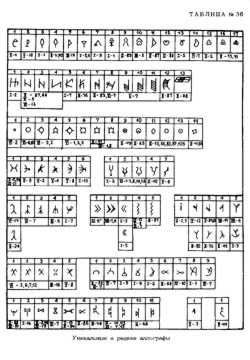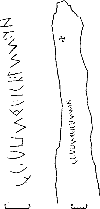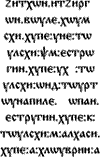Scripts Adopted by Türkic Peoples
|
Introduction |
||||
During the millenniums of their history on the expanses of Eurasia, the Türkic-speaking people used their own and adopted systems of writing. It is preposterous to suggest that a Eurasian family of peoples comprising now 85+ nations that populate Eurasia from one end to the other was illiterate. Throughout their known history, Türkic people bordered on literate people, ruled over literate people, had literate people in their midst, lived amidst literate people, and could not have escaped literacy even if they tried to very hard. The notion that the greatest empires of their days, the Eastern and the Western Hunnic Empire, and their descendents, could exist without literate administrative apparatus is derisory. The most widespread, during the last seven centuries of the present era, was the use of the Arabic alphabet, adopted with the spread of Islam among Türks. In the last century the Arabic alphabet was mostly replaced by the Latin-derived alphabets, and now the Arabic alphabet is used by the Türks only in the countries where it is a national script: Afghanistan, Iran, Iraq, Jordan, Pakistan, Syria. In the countries controlled by the USSR, a whirlwind, designed to break the spine of intellectuality, first forbade the Arabic script and its writings, replacing it with a Latin, and soon the Latin script was rabidly replaced by a variety of custom-deformed Cyrillic-derived mutually almost incomprehensible scripts for each administrative division of the subdivided country. In the territory controlled by the PRC, the Latin script was introduced for two decades, and then Arabic script was re-institutionalized. The following collection illustrates the scripts in use prior to the adoption of the Arabic script as a "lingua franca" between the Türkic people. It should be earnestly stressed that the dating of the most artifacts is purely conjectural, reflecting perfectly the perceptions of the reporters but not the facts. In those cases when the artifacts are not self-dating, the real scientific dating analysis is still pending. The collection is a little sampling, it is far from being even a simple systematic collection. |
||||
| Scripts | ||||
Türkic Script |
||||
| Title | Period | Spread | Type | To see it |
|---|---|---|---|---|
| Issyk | 500 BC | Kazakhstan | Oldest inscription in Türkic alphabet
À. Àmanjolov |
 |
| Horezm | 200 BC | Horezm, Sogd | Turanian Writing Azgar Mukhamadiev |
 |
| Aramaic | 100 AD | Parthian | Middle Eastern Aramaic |
 |
| Türkic | 300 - 800AD | S. Caucasus: Azerbaijan and Iran | Azerbaijan and Iran Dr. Farid Alakbarov |
 |
| Hunnic | 300 - 1000 AD | E. Europe | Turanian Writing Azgar Mukhamadiev |
 |
| Euro Asiatic Isfar | 500 - 700 AD | Fergana | Writings Of Eurasian Steppes Kyzlasov I.L |
 |
| Orkhon | 500 - 900 AD | E. Central Asia | Classical and widely known |
 |
| Euro Asiatic Achiktash | 600 - 700 AD | Jety-Su | Writings Of Eurasian Steppes Kyzlasov I.L |
 |
| Euro Asiatic S. Enisei (Orkhon) | 700 - 900 AD | E. Central Asia | Writings Of Eurasian Steppes
Kyzlasov I.L |
 |
| Euro Asiatic Kuban | 800 - 1200 AD | Kuban, Don | Writings Of Eurasian Steppes
Kyzlasov I.L |
 |
| Hungarian | 500 AD - Present | Central Europe | Sekler Rovash script - Khazar script Gabor Hosszu |
 |
| Asiatic | ||||
| Enisei | ||||
| Talas | ||||
Glagolic Script |
||||
| Glagolic | ||||
Cyrillic Script |
||||
| Cyrillic | 800 - 1000 AD | Danube Bolgaria | Bulgarian Inscriptions Peter Dobrev |
|
Greek Script |
||||
| Greek | ca 470 BC | Scythians |
Atails coin (Gr. Ateas)
G.Dremin |
 |
| Greek | ca 800 (Guestimate) | Danube Bulgaria | Inventory record Mudrak O.A. |
 |
| Greek | 1000 AD |
Caucasus |
Tombstone Inscription (widely publicized high class Russian fake) Zgusta L. Kudaev M. Abaev V.I. Vagapov Ya.S. Kafoev A.Z. |
 |
Syriac Script |
||||
| Syriac | 1200 - 1350 AD | C. Asia |
Syriac Writings and Turkic Language according to Central Asian Tombstone Inscriptions Wassilios Klein |
 |